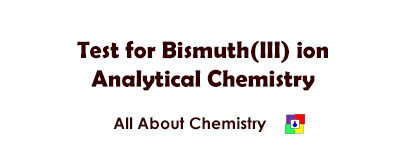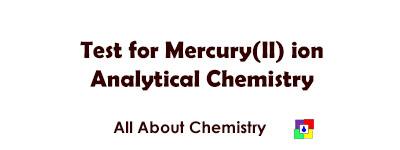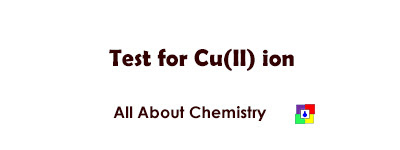Test For Silver(I) ion
1. Dilute HCl test:
When dilute HCl or any soluble chloride is added, a white ppt is obtained, which dissolves in ammonium hydroxide solution but reappears on adding nitric acid.
Ag+ + Cl– → AgCl↓
AgCl + 2NH3 → [Ag(NH3)2]+ + Cl–
Conc HCl does not give any ppt due to [AgCl2]– formation.
AgCl + Cl– → [AgCl2]–
2. Hydrogen sulphide test:
When hydrogen sulphide gas is passed or saturated aqueous solution is added, a black ppt is obtained, which dissolves in hot and conc nitric acid to yield a white ppt.
2Ag+ + H2S→ Ag2S↓ + 2H+
3Ag2S + 8HNO3 → S↓ + 2NO↑ + 6Ag+ + 6NO3– + 4H2O
3. Ammonia test:
When ammonium hydroxide solution is added, a brown ppt is obtained. The ppt dissolves in excess of the reagent.
2Ag+ + 2NH3 + H2O → Ag2O ↓+ 2NH4+
Ag2O + 4NH3 + H2O → 2[Ag(NH3)2]+ + 2OH–
The solution should be disposed of quickly, as Ag3N is formed due to decomposition, which explodes readily.
4. Sodium hydroxide test:
When sodium hydroxide solution is added, a brown ppt is obtained.
2Ag + + 2OH– → Ag2O ↓ + H2O
5. Potassium iodide test:
When potassium iodide solution is added, a yellow ppt is obtained.
Ag+ + I– → AgI↓
6. Potassium chromate test:
When potassium chromate solution is added, a red ppt is obtained. The ppt dissolves in acidic medium (turns orange) and ammonia solution.
2Ag+ + CrO42- → Ag2CrO4↓
Ag2CrO4 + 2H+ →4Ag+ + Cr2O72- + H2O
Ag2CrO4 + 4NH3 → 2[Ag(NH3)2]+ + CrO42-
7. Sodium carbonate test:
When sodium carbonate solution is added, a yellow-white ppt is obtained. On heating, the ppt decomposes to produce a brown ppt.
2Ag+ +CO32- →Ag2CO3↓
Ag2CO3→ Ag2O ↓ + CO2↑
8. Disodium hydrogen phosphate test:
When disodium hydrogen phosphate solution is added, a yellow ppt is obtained. The ppt dissolves in nitric acid and ammonia solution.
3Ag+ + HPO42- → Ag3PO4↓ + H+
Ag3PO4↓ + H+→ 3Ag+ + HPO42-
Ag3PO4 + 6NH3 → 3[Ag(NH3)2]+ + PO43-
9. Rhodanine test:
The silver solution is treated with nitric acid followed by 1 drop of p-dimethylaminobenzylidene-rhodanine solution, a reddish-violet ppt is formed.










